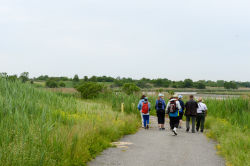Freshkills Park
William T. Davis Wildlife Refuge
What was here before?
The surrounding community, which is now called Travis, used to be called Linoleumville. The nation’s first linoleum factory, The American Linoleum Manufacturing Company, opened here in 1873 and employed 200 people by the end of its first decade of operation. A small town, complete with streets and a school, developed around the factory. This property remained open marshland, though portions were owned by several individuals, including heirs of the Winants, one of the earliest settler families in Staten Island. In 1928, the Sandura-Wild Corporation of Philadelphia purchased the plant, and two years later moved operations back to Pennsylvania, closing the factory here.
How did this site become a park?
In 1928, naturalist William T. Davis and the Audubon Society successfully secured 52 acres here as a wildlife and bird sanctuary. It was the first such wildlife preserve in New York. The next year, the City acquired 157.62 acres of surrounding land from the Crystal Water Company, which bottled and sold the spring water that still flows throughout this property, though no longer drinkable.
In 1948 the Fresh Kills Landfill was established just south of this property, and by 1955 it was the largest landfill in the world. Around the same time, the refuge’s acreage was expanded to protect the surrounding marshland from being filled in and developed. Over the next several decades, the property continued to grow, and in 1982, when it was 375 acres, it was officially named the William T. Davis Wildlife Refuge.
In 1996, a state law was passed that required the landfill to cease accepting solid waste in 2001. That same year, the city announced a competition for the design of Freshkills Park. By 2022, the site’s four “mounds” were closed and covered with a thick, impermeable cap. The Wildlife Refuge was subsumed within the larger park, which is being constructed in phases over decades.
Besides providing a green space for passive outdoor recreation, the refuge also provides the surrounding community with water pollution filtration and a natural flood control system. Many birds make their homes in this park’s marshes, including herons, egrets, ibis, cormorants, and gulls. On the ground and in the water, snapping turtles, fiddler crabs, and muskrats can be seen throughout the site.
Who is this park named for?
William Thompson Davis (1862-1945), whose family history on Staten Island dates to the 17th century, was born in New Brighton. Davis was a renowned naturalist and entomologist, and a co-founder of the Natural Science Association of Staten Island. He was largely self-taught but made significant contributions to the study of Staten Island’s community and natural history. His 1892 memoir Days Afield on Staten Island catalogs the island’s plants and animals, while Staten Island and its people, which he co-authored with Charles W. Leng (1859-1941) in 1930, is one of the greatest accounts of Staten Island history.
Check out your park's Vital Signs
Clean & Safe
Green & Resilient
Empowered & Engaged Users
Share your feedback or learn more about how this park is part of a
Vital Park System










